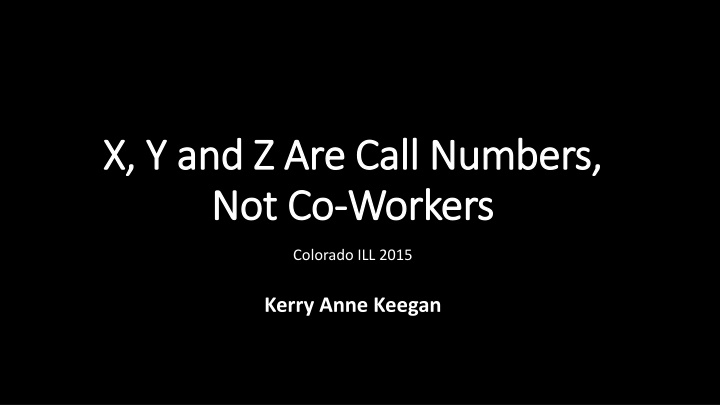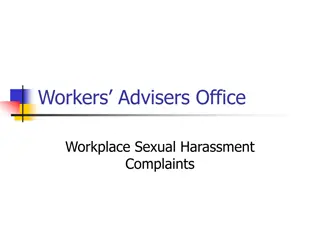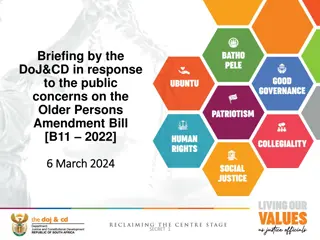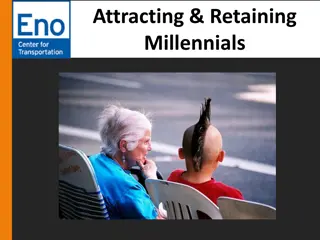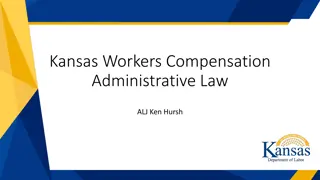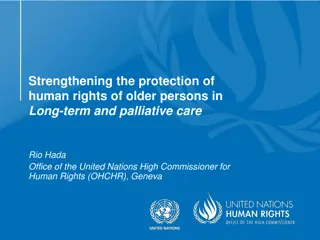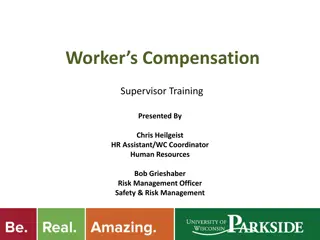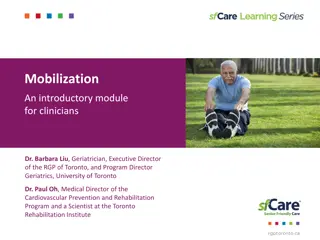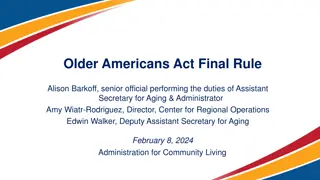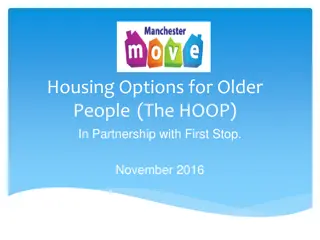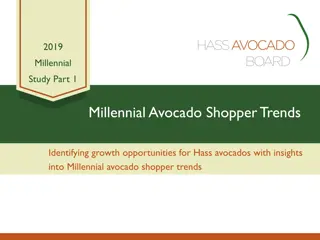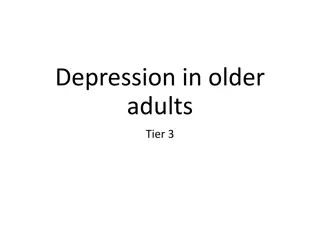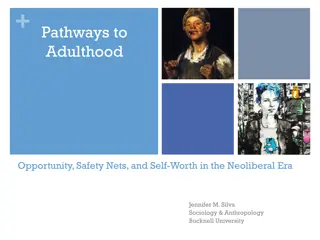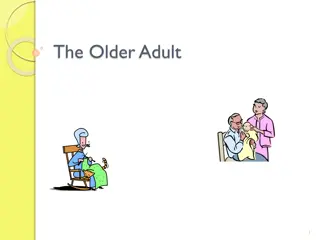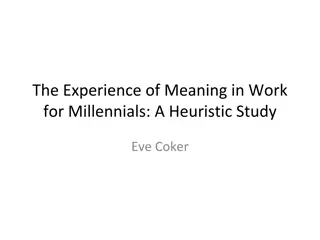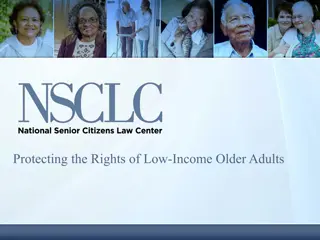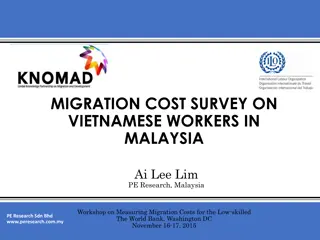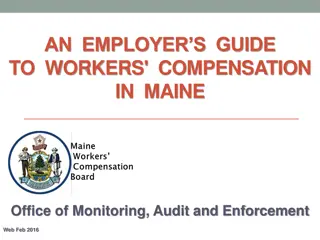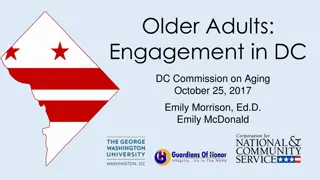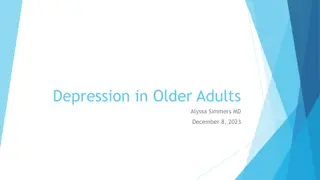Insights on Older Workers and Millennials
This content delves into the dynamics of older workers and millennials in the workforce, exploring age-related perceptions, employment trends, and the impact of technology gaps. Discover the perspectives of Kerry Anne Keegan, an experienced professional in library sciences, and gain insights into the shifting demographics of the labor market. Learn about the challenges and opportunities faced by older workers and the upcoming dominance of millennials in the workforce. Gain a unique understanding of the evolving workforce landscape and the strategies needed to navigate changing employment paradigms.
Download Presentation

Please find below an Image/Link to download the presentation.
The content on the website is provided AS IS for your information and personal use only. It may not be sold, licensed, or shared on other websites without obtaining consent from the author.If you encounter any issues during the download, it is possible that the publisher has removed the file from their server.
You are allowed to download the files provided on this website for personal or commercial use, subject to the condition that they are used lawfully. All files are the property of their respective owners.
The content on the website is provided AS IS for your information and personal use only. It may not be sold, licensed, or shared on other websites without obtaining consent from the author.
E N D
Presentation Transcript
X, Y and Z Are Call Numbers, X, Y and Z Are Call Numbers, Not Co Not Co- -Workers Workers Colorado ILL 2015 Kerry Anne Keegan
Kerry Keegan, MLIS, MPS I m a Customer Service Agent for Atlas Systems and serves as the implementation leader for ILLiad licensees, providing training and support for new and existing sites. From 2009 to 2012, she served as Head of Access Services for Stony Brook University s Health Sciences Library. Her interests include andragogy, instructional design, and creative uses of limited budgets. I hold a BA in English from Stony Brook University, a MS in Library and Information Science from Queens College, and a Master of Professional Studies degree, with a focus on Human Resource Management from Stony Brook University. She serves as Section Editor for RUSA STARS and is mother to Adaleigh the human and Remington the Pomeranian, who are both disgustingly cute.
http://www.thindifference.com/wp-content/uploads/2013/04/Generations-Healthcare.jpghttp://www.thindifference.com/wp-content/uploads/2013/04/Generations-Healthcare.jpg
Older Workers Age range is flexible, depending on source US Department of Labor most commonly classifies as 55 years and older Workforce surveys say majority of workers don t consider themselves older until at least 60 However, these individuals believe their employers think of them as older by 50 http://www.dol.gov/odep/topics/OlderWorkers.htm
Millennials Most research cites age range currently between 21-38 Birth years between 1980-1999, 1977-1993, No solid definition old enough to work, generally out of secondary school By 2025 will make up 75% of workforce http://www.huffingtonpost.com/dan- black/defending-gen-y-why-mille_b_2330802.html http://www.dol.gov/odep/topics/OlderWorkers.htm
Personal Experiences with the Numbers Remember: Completely disregarding everyone between ~35-55 AND Statistics can prove just about anything People are delaying retirement The labor marketplace is saturated with MLSes Technology gaps are at the heart of many stressors Change bothers everyone and changes are coming more rapidly
Employing Older Workers Percentage of retirees with part-time jobs is on the rise 84% of employers expect older workers to transition to part-time after retirement Accurately believe that full retirement creates a barrier to returning to workforce 71% believe older workers are first to be laid off during workforce reduction 86% believe that laid off younger workers are more likely to find new employment 2003 AARP survey: 46% of pre-retiree plan to work part-time during retirement Harris Interactive Survey says 17% plan to work consistently; 38% will cycle in and out Only of American workers are very confident that can retire when they d like Most surveyed doubtful of availability of Medicare and Social Security JUST LOOK AT YOUR NIGHTSTAND http://www.dol.gov/odep/documents/af4ecaa2_02c6_4f75_b9db_d39ad7754bb4.doc http://www.nasra.org/resources/aarpexecsumm.pdf.
Why older workers work out for libraries Willing to work different, fluctuating schedules Willing to serve as mentors Invaluable experience High retention rates 55% likely to stay with current employer for next 5 years Least likely group to feel burned out http://www.dol.gov/odep/documents/af4ecaa2_02c6_4f75_b9db_d39ad7754bb4.doc http://www.nasra.org/resources/aarpexecsumm.pdf.
and the respective challenges Employers worried about brain drain of aging, highly skilled workers Higher costs of employment, related to earnings, health insurance, and pensions Less likely to maintain and upgrade skills Expect to encounter and feel that they are experiencing age bias http://www.dol.gov/odep/documents/af4ecaa2_02c6_4f75_b9db_d39ad7754bb4.doc
Why Millennials are attractive library employees Comfortable with constant, real-time communication First truly-wired generation Looking for careers and workplaces that provide change and learning opportunities Sense of urgency in production and work pace http://www.foxbusiness.com/personal-finance/2011/04/18/tips-gen-y- engage-boomers-work
and the respective challenges More likely to change jobs or explore new career options Less than 43% are likely to stay in current position for the next 5 years Lowest rates of employer loyalty Report higher levels of work-related distress and restlessness http://www.dol.gov/odep/documents/af4ecaa2_02c6_4f75_b9db_d39ad7754bb4.doc
What are they both doing in the library? Millennials 43% work in public libraries; 40% in academic 26% are new librarians with a degree 25% are support staff Only 2% are supervisory librarians Over 55% hold ALA-accredited MLS/MLIS/MIS/MSIS Over 20% are current MLS/MLIS students Older workers Boomers are more than 65% of library workforce Hold majority of senior management positions Surveys indicate Boomers live to work and created the 60 hour work week ALA Survey from 2009: http://listsmart.osl.state.or.us/pipermail/libs-or/2009.../007814.html http://www.scribd.com/doc/15132651/Life-in-the-Baby-Boomer-library-world-a-survival-guide
Simply put, loads of differences and a ton of numbers. But when it came to training
There are A LOT of training preference similarities between these two groups. There s a reason that Millennials are sometimes called the Echo Boomer generation. The behaviors and attitudes of the generation are very similar to the Baby Boomer generation, with the exception of the element of competitiveness, which has been replaced by an expectation of collaboration. http://www.thefreelibrary.com/Mind+the+gap%3A+technology,+millennial+leadershi p+and+the...-a0250885096
Older Workers Millennials LIKES Peer support Mentoring Tutoring Group work with individual responsibilities Small teams Flexible schedules Mentally stimulating tasks Low physical demands LIKES Fast paced environments Real-time communication Wireless technologies Flexible schedules Cooperative environments Teamwork Structured experiential activities Positive attitudes Regular feedback Multitasking Different vocab, same basic ideas Different vocab, same basic ideas
Learning Preference Differences Older Workers Millennials Want time to digest information after receipt Prefer step-by-step, task-oriented processes Read text first, review graphics as supplemental materials Like individual responsibilities Teacher-centered learning, with teacher as sage Want purpose of instruction before it begins Use to construct logical sequences Want to process information quickly and immediately. Prefer multiple sources Prefer multi-tasking during parallel processes Simultaneous music, phone, emails Scan graphics to decide if text is worth referencing Like peer groups with shared responsibilities Learner-centric, with teacher as a guide Prefer to construct purpose of knowledge from learning experience http://niso.kavi.com/news/events/niso/.../MEC06-01- Breeding.pdf
A successful work environment must recognize reactions produced by these differences in order to synchronize Millennial and older workers inherently similar learning styles.
Older workers and Millennials both want workplaces that foster: Cooperative group work Positive, peer support networks Mental stimulation Flexibility Consistent access to feedback Open and regular communication http://pewsocialtrends.org/pubs/751/millennials-confident-connected-open-to-change
Reverse Mentorship Term coined by GE's Jack Welch in 1999 to help executives enter the Internet age Need to be able to offer and accept http://www.huffingtonpost.com/april-rudin/todays-office-odd-couple-_b_5715915.html
Keep an eye out for these stereotypes Older Workers Millennials Inflexibility Unwillingness or inability to adapt to new technologies Complacency Lack of aggression Resistance to change Fear of rejection Impatient Skeptical Arrogant Status and authority hold little weight Unproven leadership actions Overpowering aggressiveness
Best Practices & Food for Thought
Trust Expressing trust in coworkers and employees will improve worker satisfaction
Leadership that promotes worker autonomy grows business fast and experiences less turnover. Autonomous workers are more motivated Self-efficacy, confidence, resourcefulness Do more with less Responsibility for one s work was the #1 driver of employees who are willing to go above and beyond have autonomy http://www.humannatureatwork.com/articles/management_development/ Autonomy.htm
Supervisors Should Try Discussing and get buy-in for increased autonomy allowances with other managers Gather feedback from employees Ask if they have the tools, training, knowledge, and resources to run the library well Give employees assignments, but let them determine the how Let employees try new ideas, even if you re doubtful of success possibilities Turn failures into learning opportunities Publically recognize and celebrate employees who experiment and generate new ideas
Employees Should Try Ask for projects that put you in a leadership role Determine what tools, training, and resources and ASK for them Be able to provide specific examples and give the why and how of how they will help you help the library Be willing to suggest new ideas Don t be afraid to fail if you learn from the experience Recognize good ideas in yourself and in your coworkers Providing positive feedback and celebrating peers opens up doors to further communication and improvement
Flexibility is a Must Both groups cite flexibility as a top priority for workplace satisfaction http://assets.aarp.org/rgcenter/econ/i11_work.pdf
What the People Want 4 key types of employee-requested flexibility Flexibility in schedules Compressed work weeks, spreading out shifts, flextime Flexibility in place Office, satellite offices, telecommuting, combinations Flexibility in how to accomplish work goals Avoiding micromanagement, allowing employees to develop strategies that highlight personal styles, strengths, and preferences Flexibility in careers Interspersing full-time and part-time work, designating personal development time, allowing for sabbaticals and personal leave Easier to recruit and retain workers Employers must find an organizational approach that co-benefits business and labor Employees should understand that concessions go both ways
Employees are more likely to have Greater engagement Higher levels of job satisfaction Stronger intentions to remain with employers Less negative spillover from job to home and vice versa Better mental health Positive impacts of workplace flexibility Workers in more demanding jobs in less supportive workplaces report: Higher stress levels Coping difficulties Worse moods Higher levels of fatigue Negative consequences for work and home lives http://assets.aarp.org/rgcenter/econ/i11_work.pdf
Quick, but interesting tidbit 1.5 million retiring workers say they would have stayed on their jobs if employers had permitted them to work fewer hours with a corresponding reduction in pay. By 2020, 25 million Baby Boomers, who make up more than 40 percent of the U.S. labor force, will be exiting the workforce in large numbers and leaving many jobs to be filled. With their departure, the work characteristics that define the Baby Boomer generation results-driven, ambitious, idealistic, competitive, optimistic, and people-oriented may be lost unless companies creatively develop strategies to simultaneously retain older workers and transition their knowledge to younger workers (Morton, Foster, & Sedlar, 2005). These workers will also take decades of accumulated organizational knowledge with them, and this brain drain could result in the loss of key information about customers or practices that could be devastating to organizations (Pitt-Catsouphes & Matz-Costa, 2009). http://assets.aarp.org/rgcenter/econ/i11_work.pdf http://www.dol.gov/cgi-bin/leave-dol.asp?exiturl=http://www.gao.gov/products/GAO-07- 433T&exitTitle=www.gao.gov&fedpage=yes
Feedback Feedback Employer-worker and worker-worker feedback must be constantly available and always constructive
Show off Your Stretching Skills Boomers are often criticized for providing directives rather than guidance and rarely provide constructive or positive feedback Baby Boomers will often quote statements such as why should I thank them for doing their job or you get thanked for your work every pay day Millennials need instantaneous communication and feedback If feel like not receiving enough, they have to be prepared to ask for it but also need to feel that will not be ostracized or criticized for asking Baby Boomers are motivated by respect, so by asking for advice and feedback, requestors are respecting their knowledge and experience
Proactivity Proactive policy and practice responses can help retain good talent.
Accommodate physical or cognitive demands of older workers activity Anticipate changes in physical, sensory and cognitive needs for older workers Providing for physical needs can help ease transition of changing technologies Ergonomic mouse pads, office chairs, specialty keyboards Be familiar with accessibility options in computer programs and workstation settings Screen sizes, visual queues for sounds, optimizing visual displays, speech recognition http://assets.aarp.org/rgcenter/econ/i11_work.pdf
1/3 of US workers have a boss thats younger than them 15% by ten years or more Millennials are not only current and future employees (and bosses), but also current and future users Understanding personal views will help libraries thrive Time to start rethinking: Delivery of training and development Mobile and social based preferences Vacation time Unlimited with a focus on performance, not face time Commitment to job rotation starts and continues upon hire Anticipate changes required to retain and respond to Millennial needs as workers and users http://www.forbes.com/sites/jeannemeister/2012/10/05/millennialmindse/
Transitioning Millennials into the Library Workplace In Workforce 2020 s survey, 66% of Millennials agreed with the statement, my personal drive can be intimidating to other generations in the workplace. Encourage reframing resistance to change as a chance for dialogue Millennial librarians actively seek work environments and positions that challenge them, where they can challenge the status quo. Supervisors must work with them to teach when exceptions to the rules are appropriate. Millennials tend to have a (over)confidence in their ability to lead without any prior experience, and believe that leadership is participatory. Provide opportunities for leadership experience and professional development http://www.forbes.com/sites/jeannemeister/2012/06/26/if-we-work-into-our-70s-what-happens-in-the-workplace/ http://www.thefreelibrary.com/Mind+the+gap%3A+technology,+millennial+leadership+and+the...-a0250885096
Millennial workplace values (by importance) 1. Workplace flexibility 2. Compensation 3. Career Progression 4. On-going opportunities for sharing and collaborating All of us need to adopt a Millennial mindset, regardless of when we were born. Why? In order to thrive in the workplace of the future we need to be agile, digitally literate, use the latest social technologies and above all, be open to people of all cultures, since our workforce of the future will be increasingly multi-cultural, age diverse and global. - Jeanne Meister, author of The 2020 Workplace http://www.forbes.com/sites/jeannemeister/2012/10/05/millennialmindse/
Remember, it wasn't too long ago when Gen Xers were "slackers" and Boomers were "hippies." We're all young once. http://www.huffingtonpost.com/dan-black/defending-gen-y-why- mille_b_2330802.html
Thanks so much! Kerry Anne Keegan kkeegan@atlas-sys.com
